Kathy Schmitz is back with sixteen more charming embroideries and perfect projects for gifting. Each is 2 1/2" x 4 1/2" and can be worked up in short order.
Picture Perfect includes designs with birds, a cottage, nature and garden scenes, a beehive, a cat and a bunny. I have a hard time deciding which are my favorites!
Mix and match the designs to make any number of small projects. The pillows are made with five designs.
Or, mat and frame your projects. I envision filling a small wall space with several!
Imagine how pleased friends and family would be to get one of these as a gift!
The matting images are available online to download and print.
I want to make these sachets and fill them with lavender from my garden next year!
Embroidery on a loose-woven fabric, mounted on blank cardstock or cards, creates custom notecards. I make my own cards and I love this idea!
I love Schmitz's designs and enjoy embroidery. Since these patterns are small I could take them with me to work anywhere--and complete them in short order!
I was given access to a free ebook by the publisher through Edelweiss. My review is fair and unbiased.
Picture Perfect
by Kathy Schmitz
That Patchwork Place
Publication: December 6, 2019
ISBN 9781683560401, 168356040X
Paperback $25.99 USD (-$8 less for ebook only)
Monday, December 23, 2019
Saturday, December 21, 2019
Helen Korngold Diary: December 15-21, 1919
It was Helen's last week of teaching at Wellston school before her trip to New York City to visit Herbert and Ruth Pawling! She went shopping to prepare.
December
Monday 15
School – I do love Mondays. Rushed downtown. Got a beautiful dark blue beaded camisole. Also getting a darling peach-blow evening dress. Have some wonderful suede pumps.
Tuesday 16
School seems a nuisance these days. Downtown, bought a dear black jersey silk petticoat & silk stockings. Bought a green silk dress – silver lace & cloth – gorgeous. Have a cute blue hat to match my new fur-trimmed blue coat.
Wednesday 17
This was a good day. Children were angelic. Milton Breschel came over.
Thursday 18
Bought a blue suit trimmed in nutria fur. It’s real cute. I have some beautiful handkerchiefs, combs, etc. Also have a pretty white georgette plainly embroidered.
Friday 19
Expect to leave for N.Y. tomorrow. Thrilling. I’m almost thru shopping. Gave my children a Xmas party – a piece of candy for each & a John Hancock pencil. Had a program for everything. Beck bought my bag and packed my trunk.
Saturday 20
Went to Wellston, got my check – said good-bye to Grammie, Grandpa & the rest of the family – bought a pair of shoes & left St Louis at 1:10 p.m. Spent a pleasant afternoon with a girl on the train.
Sunday 21
No breakfast. Felt rotten. The train was cold & hot by degrees. Went around horseshoe bend & really enjoyed the trip – but the train lost 4 hrs time & I arrived in Penn Station N.Y. 10 p.m. Met by Ruth & Herbert.
Notes:
Dec 14
El Dance was held at B’nai El in St. Louis, a founding member of the Union for Reform Judaism.
Milton D. Breschel, according to The War Record of American Jews, was on born July 8, 1892, in Milwaukee, MN. He was a commissioned officer in WWI. He was a student living in St. Louis at 5001 Gates Ave. when he entered the war. His mother was born in New York and his father was Czechoslovakian/Russian/Polish. On January 18, 1915, he was promoted to 2 Lt. working with heavy tanks. He appears in the 1914 Scranton, PA City Directory. In the 1920s and 1930s Milton D. Breschel appears in Jacksonville, FL city directories, working as a salesman and married to Fay.
Dec. 20
Perhaps Helen took the Baltimore & Ohio's St. Louis-Cincinnati-New York City Special passenger train. Two trains left St. Louis daily.
Helen's choices reflected popular styles being sold in 1919. The Dry Good Economist of 1919 noted color trends including 'National' blue, or drapeau blue, the color of the flag as a new fashion-forward color. 'Blue Devil' blue and navy blue was popular.
Favorite dress materials included tricolette and silk jersey. Fur was a fashionable trim, especially seal, but fur was in short supply because of a fur strike. Sealion and Nurtria were used instead. Nutria fur was from the coypu or swamp rat, originally imported from South America, somewhat like beaver fur.
Chemise models of dresses were the narrow skirted dresses that fell straight from shoulder to knee.
Wool and silk and georgette dresses were embellished with colored embroidery, jet and steel beading, and soutache braid.
Camisoles were undergarments worn over the brassiere, now coming into their own as an outer garment.
The suits below show the narrow profile that would define the 1920s. Not the hemlines are above the ankle.

These dresses show the fuller silhouette that was becoming passe.


Perhaps Helen's green silk dress embellished with silver lace looked like this dress:


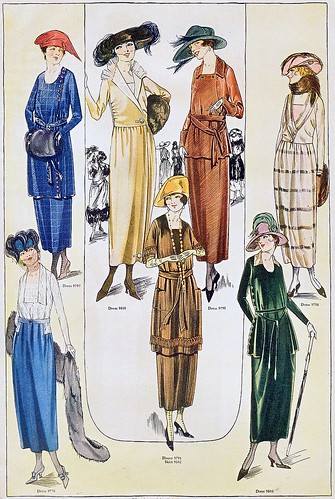
These petticoats are quite full.

Trendy colors from Paris for evening apparel include a 'peachblow' dress on the right.
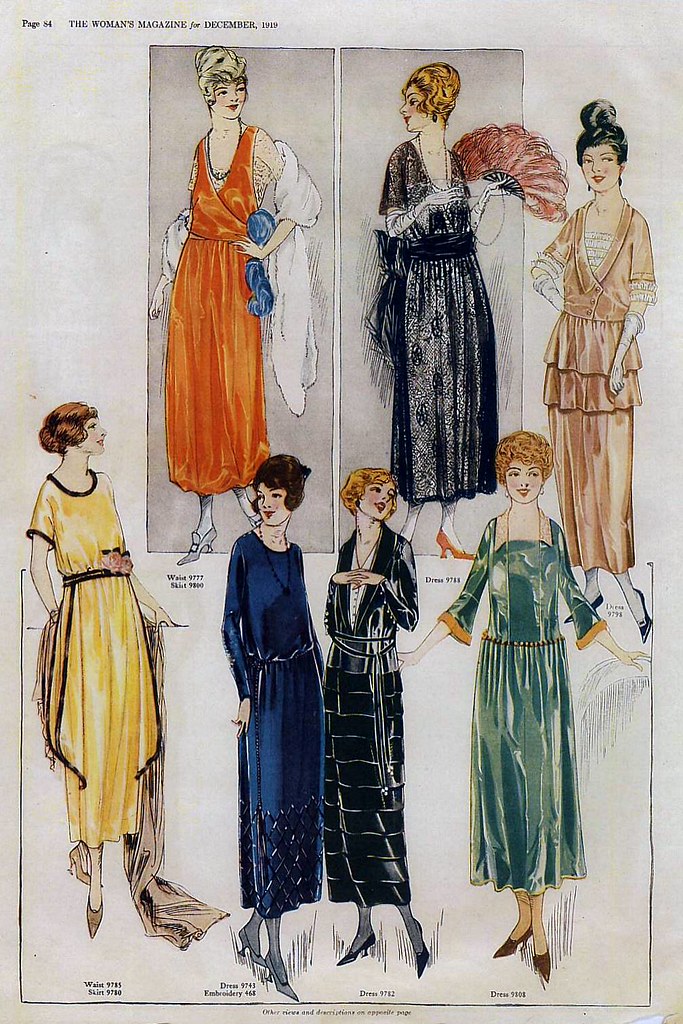
As ankles were being shown, stockings featured designs on the ankles and lower legs.

December
Monday 15
School – I do love Mondays. Rushed downtown. Got a beautiful dark blue beaded camisole. Also getting a darling peach-blow evening dress. Have some wonderful suede pumps.
Tuesday 16
School seems a nuisance these days. Downtown, bought a dear black jersey silk petticoat & silk stockings. Bought a green silk dress – silver lace & cloth – gorgeous. Have a cute blue hat to match my new fur-trimmed blue coat.
Wednesday 17
This was a good day. Children were angelic. Milton Breschel came over.
Thursday 18
Bought a blue suit trimmed in nutria fur. It’s real cute. I have some beautiful handkerchiefs, combs, etc. Also have a pretty white georgette plainly embroidered.
Friday 19
Expect to leave for N.Y. tomorrow. Thrilling. I’m almost thru shopping. Gave my children a Xmas party – a piece of candy for each & a John Hancock pencil. Had a program for everything. Beck bought my bag and packed my trunk.
Saturday 20
Went to Wellston, got my check – said good-bye to Grammie, Grandpa & the rest of the family – bought a pair of shoes & left St Louis at 1:10 p.m. Spent a pleasant afternoon with a girl on the train.
Sunday 21
No breakfast. Felt rotten. The train was cold & hot by degrees. Went around horseshoe bend & really enjoyed the trip – but the train lost 4 hrs time & I arrived in Penn Station N.Y. 10 p.m. Met by Ruth & Herbert.
Notes:
Dec 14
El Dance was held at B’nai El in St. Louis, a founding member of the Union for Reform Judaism.
Milton D. Breschel, according to The War Record of American Jews, was on born July 8, 1892, in Milwaukee, MN. He was a commissioned officer in WWI. He was a student living in St. Louis at 5001 Gates Ave. when he entered the war. His mother was born in New York and his father was Czechoslovakian/Russian/Polish. On January 18, 1915, he was promoted to 2 Lt. working with heavy tanks. He appears in the 1914 Scranton, PA City Directory. In the 1920s and 1930s Milton D. Breschel appears in Jacksonville, FL city directories, working as a salesman and married to Fay.
Dec. 20
Perhaps Helen took the Baltimore & Ohio's St. Louis-Cincinnati-New York City Special passenger train. Two trains left St. Louis daily.
The St. Louis Limited traveled over 1000 miles in "scarcely a day" from St. Louis to New York City, passing through Indianapolis, IN, Dayton and Columbus, OH, Pittsburgh, Harrisburg, and Philadelphia, PA. "This is the only train composed of Pullman cars exclusively. A library-smoking car, buffet, bath and barber appliances, a Pennsylvania Lines diner, a compartment-observation car, and three drawing-room sleeping cars made up the equipment."(found in Goggle Books Railway World.)
*****
1919 Fashion and HelenHelen's choices reflected popular styles being sold in 1919. The Dry Good Economist of 1919 noted color trends including 'National' blue, or drapeau blue, the color of the flag as a new fashion-forward color. 'Blue Devil' blue and navy blue was popular.
Favorite dress materials included tricolette and silk jersey. Fur was a fashionable trim, especially seal, but fur was in short supply because of a fur strike. Sealion and Nurtria were used instead. Nutria fur was from the coypu or swamp rat, originally imported from South America, somewhat like beaver fur.
Chemise models of dresses were the narrow skirted dresses that fell straight from shoulder to knee.
Wool and silk and georgette dresses were embellished with colored embroidery, jet and steel beading, and soutache braid.
Camisoles were undergarments worn over the brassiere, now coming into their own as an outer garment.
The suits below show the narrow profile that would define the 1920s. Not the hemlines are above the ankle.

These dresses show the fuller silhouette that was becoming passe.


Perhaps Helen's green silk dress embellished with silver lace looked like this dress:

1919 fashion illustration shows the simple white dress still popular. Helen's was made of georgette and simply embroidered.

Dec 1919 fashion illustration includes the trendy 'national' blue along with the capuchine yellow that was the other new in color.

These petticoats are quite full.

Trendy colors from Paris for evening apparel include a 'peachblow' dress on the right.

As ankles were being shown, stockings featured designs on the ankles and lower legs.

Wednesday, December 18, 2019
Blue and White Quilts
Blue has been my favorite color for most of my life.
The color blue is associated with the wide expanses of water and sky, bringing a sense of serenity and peace. It slows our pulse, calms our mind. Paired with white, it can recall an intense blue sky over a field of snow. It feels clean and brisk.
Dark blue is rated a favorite color. It has gravitas, appealing to men, and is used for corporate logos. It is thoughtful and reliable.
Light blues are used in logos for health organizations. It feels soft and approachable, perfect for babies. It is the color of purity, the color of the Virgin Mary's robe.
It is no wonder that blue and white quilts attract attention.
Now, That Patchwork Place is offering quilters a whole book of quilt patterns on this color scheme!
Blue and White Quilts includes 13 patterns from well-known designers like MODA designers Lissa Alexander and Lisa Bonegean.
I love the subtle variation in blues in the star quilt above. It makes the stars twinkle!
Blue and white antique quilts inspired some of these patterns. But the instructions are not antique--all the modern tricks and hints and methods are included.
The nine-patch variation quilt above would be a great way to use up a stash of blue fabrics! It uses a strip-piecing method. I love how the nine-patch white corner squares are against the white background, giving the quilt a light and airy look!
This Hunter's Star is not as difficult as it looks, thanks to the method used in this book.
The classic Tree of Life pattern uses Star Singles papers.
An applique border on a pieced quilt always brings it to the next level.
Sapphire Star is made of nearly 2,000 half-square triangle units. Lisa's secret is starch.
Sherri's design Timeless is inspired by an antique quilt.
I love applique and this medallion style wall hanging combines flowers and birds with Wild Goose Chase borders.
The antique quilt above proves that all blues go together!
White stars on a navy background bring a modern vibe to a traditional pattern.
I love the curved appeal of orange peel! Usually, the pattern is set side-by-side, but this variation with a double border and four-patch units is just wonderful. Don't fret about curves: this is an easy applique quilt!
Which blue and white quilt is now on your list to make?
I was given access to a free ebook in exchange for a fair and unbiased review.
Blue and White Quilts
That Patchwork Place
December 6, 2019
ISBN 9781683560395, 1683560396
Paperback & ebook $27.99 USD
(ebook alone -$8)
Find my review of Red & White Quilts here.

The color blue is associated with the wide expanses of water and sky, bringing a sense of serenity and peace. It slows our pulse, calms our mind. Paired with white, it can recall an intense blue sky over a field of snow. It feels clean and brisk.
Dark blue is rated a favorite color. It has gravitas, appealing to men, and is used for corporate logos. It is thoughtful and reliable.
Light blues are used in logos for health organizations. It feels soft and approachable, perfect for babies. It is the color of purity, the color of the Virgin Mary's robe.
It is no wonder that blue and white quilts attract attention.
Now, That Patchwork Place is offering quilters a whole book of quilt patterns on this color scheme!
Blue and White Quilts includes 13 patterns from well-known designers like MODA designers Lissa Alexander and Lisa Bonegean.
 |
| Country Surprise by Nancy Mahoney, 77 1/2" x 77 1/2" |
 |
| Cornered by Jill Shaulis,79" x 79" |
 |
| To the Nines by Camille Roskelley, 63 1/2" x 75 1/2" |
 |
| Antique quilt from the collection of Jennifer Keltner, 52 1/2" x 65 1/2" |
 |
| Tree of Life by Paula Barnes, 98 1/2" x 98 1/2" |
 |
| Bliss by Debbie Roberts, 70 1/2" x 70 1/2" |
 |
| Sapphire Star by Lisa Bongean, 80 1/2" x 80 1/2" |
 |
| Timeless designed by Sherri McConnell, 53" x 53" |
 |
| Singing the Blues designed by Helen Stubbings,4 8 1/2" x 48 1/2" |
 |
| Antique Album, collection of Jennifer Keltner, 70 1/2" x 81 3/4" |
 |
| Midnight Sky by Laurie Simpson, 41" x 41" |
 |
| Blueberry Crumb Cake by Lissa Alexander, 75 1/2" x 85 1/2" |
 |
| Baskets in Blue antique quilt in the collection of Julie Hendricksen, 62 1/2" x 71 1/8" |
I was given access to a free ebook in exchange for a fair and unbiased review.
Blue and White Quilts
That Patchwork Place
December 6, 2019
ISBN 9781683560395, 1683560396
Paperback & ebook $27.99 USD
(ebook alone -$8)
Find my review of Red & White Quilts here.

Tuesday, December 17, 2019
To the Stars Through Difficulties Audiobook

The To the Stars Through Difficulties audiobook was a fantastic way to revisit Romalyn Tilghman's delightful novel.
Daniela Acitelli has a clear, articulate voice. Tilghman crafted each character with a specific voice, telling their stories first-person; the narrator interpreted the characters brilliantly.
The audiobook is over ten hours long and I listened while sewing and doing handwork. Which is so appropriate for a novel about art quilter Traci teaching traditional quilters to expand their craft in new ways!
Listening to the audiobook I appreciated again Tilghman's humor and her insight into the human experience.
The novel brings together East Coasters and Kansas natives.
Traci was an unwanted 'dumpster baby' and adopted child. She is hired to teach at the Carnegie library turned art center, including a group of problem teenagers. Distrustful and knowing she is a fraud, Traci unexpectedly discovers she is a good teacher and role model--and is worthy of love.
Angelina is researching the Carnegie library her grandmother helped to build, looking to belatedly completing her thesis. Along the way, Angelina discovers family secrets and a new path.
Kansas native Gayle's hometown has been wiped off the map by a tornado. She struggles with the loss of her entire world. Gayle discovers the courage to start over.
This is a novel about women who rise above the challenges of life, who find community and love and purpose.
I was given a free audiobook in exchange for a fair and unbiased review.
Read my 2017 review of the novel here.
A Kansas Notable Book of the Year 2018
2017 Foreword INDIES Book of the Year Awards: Finalist
2017 IPPY Awards: Contemporary Fiction, Gold Medal
Readers’ Favorite: Gold Medal Award for Women’s Fiction
2017 Foreword Indie Finalist in Adult Fiction—General
2018 Next Generation Indie Book Awards Finalist in General Fiction/Novel (Over 80,000 words)
Pulpwood Queen Selection, June 2018To The Stars Through Difficulties
by Romalyn Tilghman
She Writes Press
Audiobook $21.83
ASIN: B0811XF964
Sunday, December 15, 2019
This is Going to Hurt: Secret Diaries of a Medical Resident by Adam Kay
Warning: this book is going to hurt.
Your body will hurt from laughter. Your laughter will irritate those around you and you will be relegated to a separate room, causing hurt feelings. Or--they will be jealous of the fun you are having and that will hurt their feelings.
Your head will hurt considering all the things that can go wrong in delivering a baby.
And your heart will hurt learning the sacrifices and ordeals required to become a doctor.
In This Is Going to Hurt, Adam Kay, NHS ob/gyn doctor shares stories from the surgical rooms and hospital beds that are unbelievable. I can't even share some of the stories here. Let's just say that people can do some pretty strange things and eating a hospital spoon is one of the less strange ones in this book. His stories in the delivery room can be pretty funny and pretty gruesome.
Kay can be politically incorrect and some of his stories are scandalous.
And yet I 'got' so much of his experience.
There are the high costs of becoming a doctor: expensive schooling, the long hours, being on call, the lack of time for a personal life and family, the meager salary and unpaid overtime, the emotional drain that makes you create a hard shell, the stress, the burn-out. Many professionals can relate to these issues.
It is the heavy burden of being held accountable for life and death decisions that is unique to medical careers. Human error--a slip of the hand or a misdiagnosis in the medical record, the things you can't control--and the doctor goes home feeling they weren't good enough, alert enough, smart enough, lucky enough.
Kay's experience in the British National Health Service could be a warning to Americans considering national health care options. To keep costs down, the NHS caps salaries. Low pay and long hours contribute to staffing problems.
Kay mentions he has to pay for parking. So do patients. Some doctors leave England to work in for-profit systems.
But the UK medical system rating is quite a bit above the US. It's doing something right.
Kay's writing reminded me of David Sedaris. I laughed, I was embarrassed by what I was laughing at, and Kay engaged my mind and my heart.
I received access to a free ebook through NetGalley. My review is fair and unbiased.
This Is Going to Hurt: Secret Diaries of a Medical Resident
by Adam Kay
Little, Brown and Company
Pub Date 03 Dec 2019
ISBN 9780316426725
PRICE $28.00 (USD)
Your body will hurt from laughter. Your laughter will irritate those around you and you will be relegated to a separate room, causing hurt feelings. Or--they will be jealous of the fun you are having and that will hurt their feelings.
Your head will hurt considering all the things that can go wrong in delivering a baby.
And your heart will hurt learning the sacrifices and ordeals required to become a doctor.
In This Is Going to Hurt, Adam Kay, NHS ob/gyn doctor shares stories from the surgical rooms and hospital beds that are unbelievable. I can't even share some of the stories here. Let's just say that people can do some pretty strange things and eating a hospital spoon is one of the less strange ones in this book. His stories in the delivery room can be pretty funny and pretty gruesome.
Kay can be politically incorrect and some of his stories are scandalous.
And yet I 'got' so much of his experience.
There are the high costs of becoming a doctor: expensive schooling, the long hours, being on call, the lack of time for a personal life and family, the meager salary and unpaid overtime, the emotional drain that makes you create a hard shell, the stress, the burn-out. Many professionals can relate to these issues.
It is the heavy burden of being held accountable for life and death decisions that is unique to medical careers. Human error--a slip of the hand or a misdiagnosis in the medical record, the things you can't control--and the doctor goes home feeling they weren't good enough, alert enough, smart enough, lucky enough.
Kay's experience in the British National Health Service could be a warning to Americans considering national health care options. To keep costs down, the NHS caps salaries. Low pay and long hours contribute to staffing problems.
Kay mentions he has to pay for parking. So do patients. Some doctors leave England to work in for-profit systems.
But the UK medical system rating is quite a bit above the US. It's doing something right.
Kay's writing reminded me of David Sedaris. I laughed, I was embarrassed by what I was laughing at, and Kay engaged my mind and my heart.
I received access to a free ebook through NetGalley. My review is fair and unbiased.
This Is Going to Hurt: Secret Diaries of a Medical Resident
by Adam Kay
Little, Brown and Company
Pub Date 03 Dec 2019
ISBN 9780316426725
PRICE $28.00 (USD)
Saturday, December 14, 2019
Helen Korngold Diary: December 8-14, 1919
 |
| Helen Korngold, Dec. 1919, New York City |
Monday 8
School – Monday is always such a bright day. Mama bought a black tricolette for me also a darling blue velvet.
Tuesday 9
Working hard – comparatively. This is a good time to spur them on.
Wednesday 10
Letter from Ruth [Pawling] in which she asks me to come to N.Y. Thrilling.
Thursday 11
Coming along fine
Friday 12
Last day of school until Monday. I’m crazy about this bunch of youngsters.
Saturday 13
Downtown – Did some shopping
Over at Isenkramers for a party. Had a good time.
Sunday 14
Sunday School – children were so sad to hear that I was leaving for New York. I am happy as a bee. B’nai – El Dance. Met Milton Breschel. A regular hero – traveled all over the world.
Notes:
Dec 8
Is Helen wearing the blue velvet dress in her New York City photograph? It looks like it could be velvet!
Tricolette is a silk or rayon knitted fabric for women’s wear.
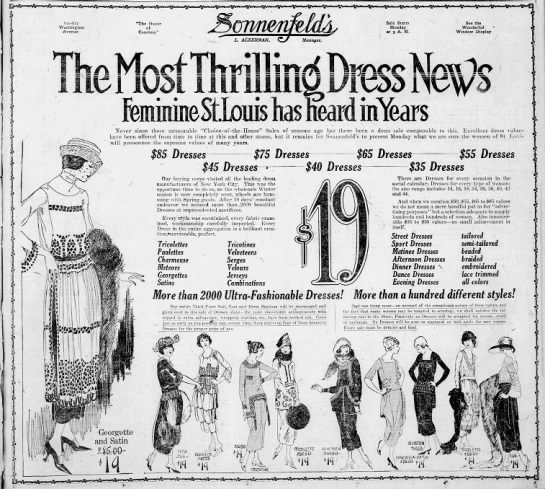 |
| St Louis Post-Dispatch ad Dec. 7, 1919, showing Tricolette dress at $19 |

 |
 |
Dec 13
Isenkramers is perhaps the family of Ludwig Eisenkramer (1877-1942) who on the 1920 St. Louis Census was a draftsman and engineer living on Evans St. His wife was Frieda (nee’ Brasch) and they had three children, Florence, Charles and Henry, all in their teens or younger. Ludwig arrived in the U.S. in 1904 from Alsace Lorraine, of German heritage, and became a citizen in 1925. His 1918 WWI Draft registration show he was stout, of medium height, with black hair and brown eyes. In 1938 he is an engineer/salesman in the St. Louis City Directory. A very good genealogy can be found on ancestry.com.

Dec 14
El Dance was held at B’nai El in St. Louis, a founding member of the Union for Reform Judaism.
Milton D. Breschel, according to The War Record of American Jews, was on born July 8, 1892, in Milwaukee, MN. He was a commissioned officer in WWI. He was a student living in St. Louis at 5001 Gates Ave. when he entered the war. His mother was born in New York and his father was Czechoslovakian/Russian/Polish. On January 18, 1915, he was promoted to 2 Lt. He worked with heavy tanks. He appears in the 1914 Scranton, PA City Directory. In the 1920s and 1930s, Milton D. Breschel appears in Jacksonville, FL city directories, working as a salesman and married to Fay.
In the News:
The Dec 12, 1919, The Jewish Voice had an article on the movement to keep children in school. To keep teachers there was a movement to raise their salary. Helen's career choice was very important.
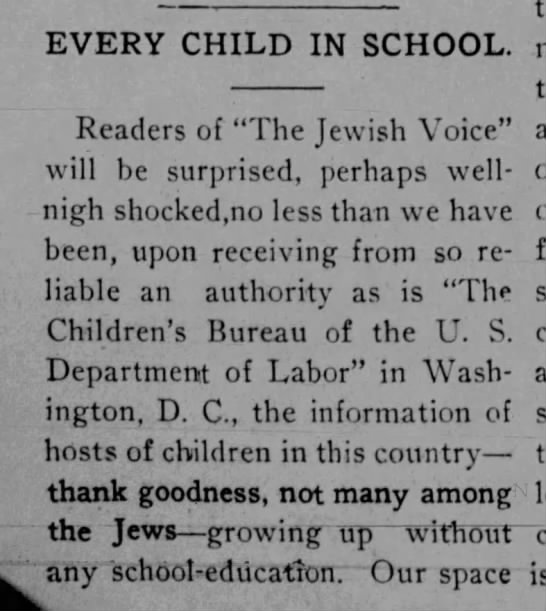
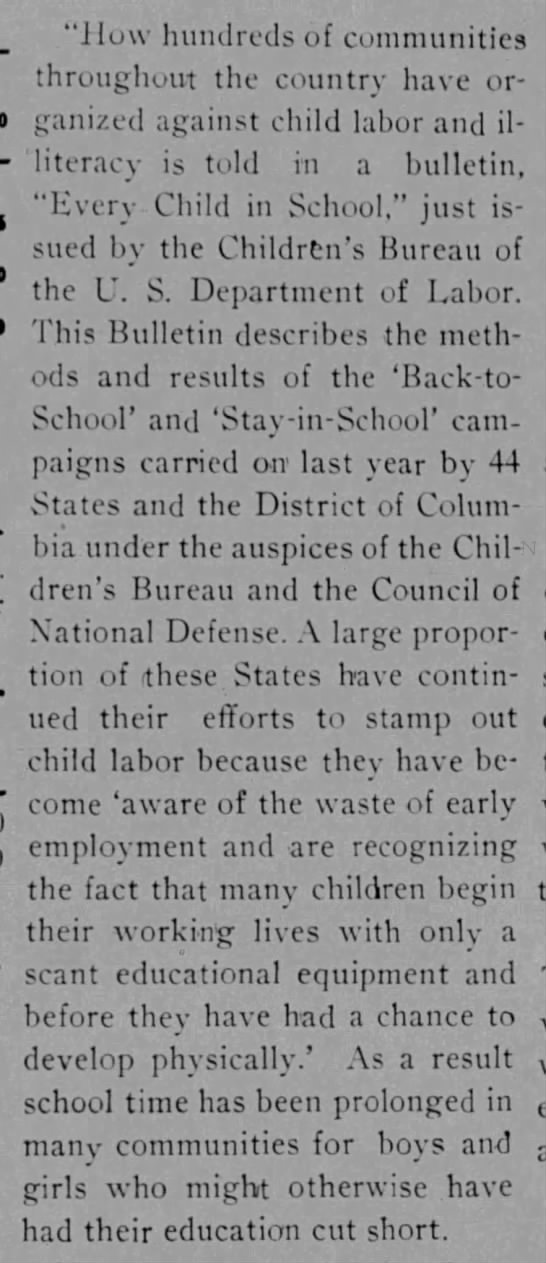

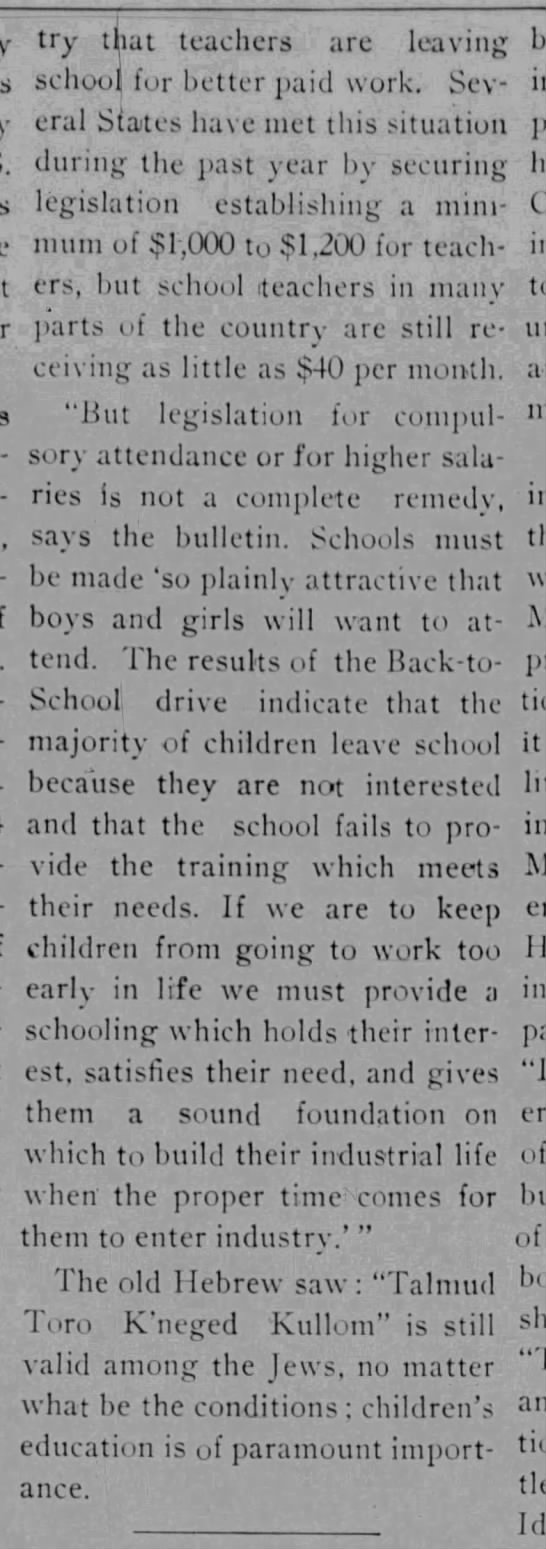
Money was being raised for the Jewish Hospital Fund. This week's contributions came from people in Helen's life including S. J. Russack of United Hebrew Temple and Prof. Langsdorf of Washington University.

The Dec. 13, 1919, St. Louis Star and Times ran this editorial cartoon:
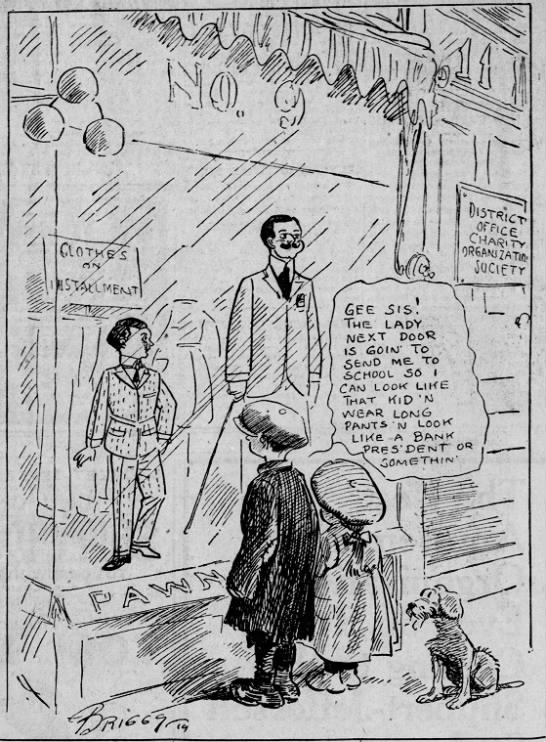
A St. Louis war hero was in the news. Miss Julia Stimson was the head of Army Nurses during WWI.
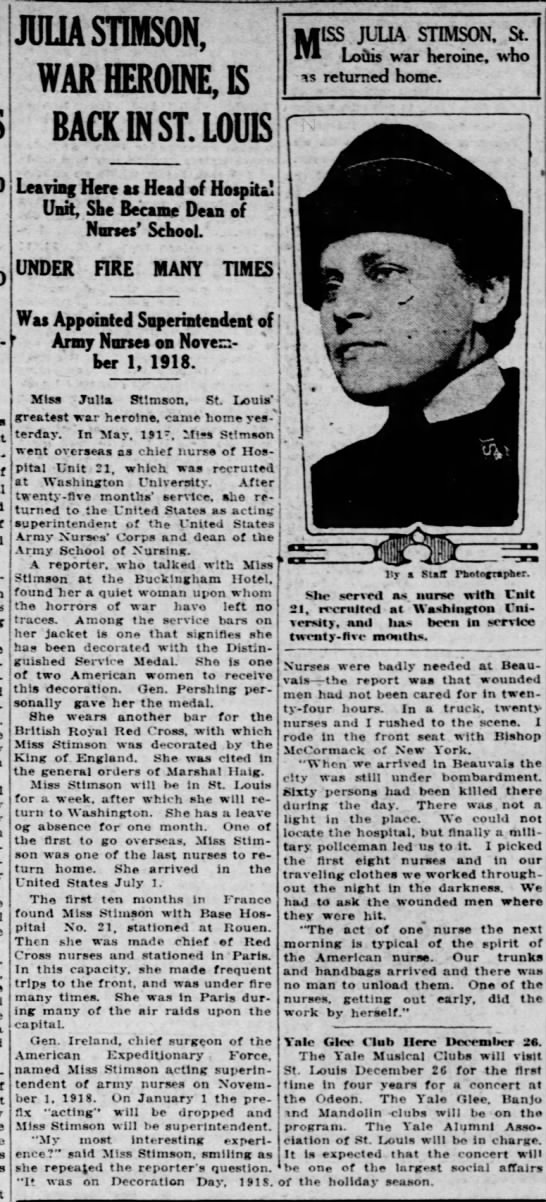
Tuesday, December 10, 2019
The Book of Science and Antiquities by Thomas Keneally
On the night after finishing The Book of Science and Antiquities, I dreamt of my father.
December ten years ago my father died from Non-Hodgkins lymphoma.
I spent two months at his hospital bedside. During that time, he slipped from sociability into a drug-induced alternate reality. He laughed and told me long stories, but I could only understand a word or two.
This novel about "last things," the story and death of a man in the present time and the story and death of a man who lived 40,000 years ago, reached into my memory and in that dream, I relived a moment when my father was trying to tell me memories, or visions, while I listened hoping to catch his vision.
I consider rereading the novel's ending after my dream. Perhaps when I am ready for a good cry.
****
The novel is dedicated to Keneally's friend who found Mungo Man, and the storyline of this novel is inspired by this history.
The fictional Shelby Apple filmed the finding of Learned Man whose remains were taken for scientific study. Now Shelby works to return Learned Man to his people.
Shel has been diagnosed with cancer and his narrative illuminates his past and his grappling with impending death. Alternate chapters is in Learned Man's voice, telling of his world and life, climaxing with his sacrificial act to protect his community.
Both timeline stories kept my interest, but it was Learned Man who caught my attention early in the book. The imagined society and people are beautifully described. I saw parallels in the human experience of both men, for neither time or technology alter the basic human quest for love, meaning, and community.
Finding that Keneally had prepared for the priesthood and was ordained a deacon as a young man was no surprise considering the novel's conclusion. I relished this existential talk.
Although Thomas Keneally has written fifty books, including the Booker Prize winner Schindler's Ark which inspired the movie Schindler's List, I had never read anything by him.
I was granted access to a free egalley by the publisher through NetGalley. My review is fair and unbiased.
See a photo of Mungo Man here.
Read about Mungo Man being returned home to rest here.
The Book of Science and Antiquities
by Thomas Keneally
Atria Books
Pub Date 10 Dec 2019
ISBN: 9781982121037
PRICE: $37.00 (CAD); $14.99 Kindle
Sunday, December 8, 2019
Love That Moves the Sun by Linda Cardillo: Vittoria Colonna and Michelangelo
The story of a poetess and one of history's greatest artists, Love That Moves the Sun by Linda Cardillo drew me into an age I knew little about--16th c Italy.
Vittoria Colonna left her family as a girl to live with the family of her betrothed, a politically advantageous arrangement. Vittoria flourished under her future mother-in-law's education, finding in Costanza's large library books that "lit a fire, a conflagration that burns in me to this day." And she and Ferranti's childhood friendship blossoms into passionate love.
Ferranti was raised to be a warrior and spent most of their married life fighting in the continual wars as alliances shifted between kingdoms, the Pope, and the Holy Roman Emperor. Vittoria enjoyed the freedom this allowed her while agonizing over the growing distance between her and her beloved husband.
After Ferrante's death, Vittoria retreated from the world, nursing her grief and growing her faith rooted in the Catholic Reformation. When her poetry was shared with the world, she became doubly famous as the finest poet since Petrarch and as the virtuous widow who gave up worldly pleasures and stellar marriage opportunities.
When she meets Michelangelo they become soul mates, their relationship deepening as they commune over how art fuels faith. As the artist works on The Last Judgement mural in the Sistine Chapel, Vittoria writes a volume of poetry for him.
Although rooted in history, Vittoria's story touches on eternal themes: The position, power, and struggle for self-determination of women of intelligence and ability; Vittoria's progressive atittude toward personal faith that challenged authority; and the timeless anguish of women whose beloved husbands and sons go to war.
I learned much about Italy's history and the cycle of shifting power that fueled endless war as well as the history of Catholicism during a time when John Calvin and others were fomenting the Protestant Reformation.
I was given access to a free egalley by the publisher through NetGalley. My review is fair and unbiased.
Love That Moves the Sun
The passionate bond between Renaissance poet Vittoria Colonna and famed artist Michelangelo
by Linda Cardillo
BooksGoSocial
Pub Date 12 Dec 2018
ISBN 9781942209553
PRICE $5.99 (USD)
Sample of Vittoria's poetry found at https://www.hwlongfellow.org/poems_poem.php?pid=209
VITTORIA COLONNA, on the death of her husband, the Marchese di Pescara, retired to her castle at Ischia (Inarimé), and there wrote the Ode upon his death, which gained her the title of Divine.
Once more, once more, Inarimé,
I see thy purple hills!--once more
I hear the billows of the bay
Wash the white pebbles on thy shore.
High o'er the sea-surge and the sands,
Like a great galleon wrecked and cast
Ashore by storms, thy castle stands,
A mouldering landmark of the Past.
Upon its terrace-walk I see
A phantom gliding to and fro;
It is Colonna,--it is she
Who lived and loved so long ago.
Pescara's beautiful young wife,
The type of perfect womanhood,
Whose life was love, the life of life,
That time and change and death withstood.
For death, that breaks the marriage band
In others, only closer pressed
The wedding-ring upon her hand
And closer locked and barred her breast.
She knew the life-long martyrdom,
The weariness, the endless pain
Of waiting for some one to come
Who nevermore would come again.
The shadows of the chestnut trees,
The odor of the orange blooms,
The song of birds, and, more than these,
The silence of deserted rooms;
The respiration of the sea,
The soft caresses of the air,
All things in nature seemed to be
But ministers of her despair;
Till the o'erburdened heart, so long
Imprisoned in itself, found vent
And voice in one impassioned song
Of inconsolable lament.
Then as the sun, though hidden from sight,
Transmutes to gold the leaden mist,
Her life was interfused with light,
From realms that, though unseen, exist,
Inarimé! Inarimé!
Thy castle on the crags above
In dust shall crumble and decay,
But not the memory of her love.
See the trailer at
https://youtu.be/O1JrGveVYOc
Read an interview with the author at Book Club Babble
Vittoria Colonna left her family as a girl to live with the family of her betrothed, a politically advantageous arrangement. Vittoria flourished under her future mother-in-law's education, finding in Costanza's large library books that "lit a fire, a conflagration that burns in me to this day." And she and Ferranti's childhood friendship blossoms into passionate love.
Ferranti was raised to be a warrior and spent most of their married life fighting in the continual wars as alliances shifted between kingdoms, the Pope, and the Holy Roman Emperor. Vittoria enjoyed the freedom this allowed her while agonizing over the growing distance between her and her beloved husband.
After Ferrante's death, Vittoria retreated from the world, nursing her grief and growing her faith rooted in the Catholic Reformation. When her poetry was shared with the world, she became doubly famous as the finest poet since Petrarch and as the virtuous widow who gave up worldly pleasures and stellar marriage opportunities.
When she meets Michelangelo they become soul mates, their relationship deepening as they commune over how art fuels faith. As the artist works on The Last Judgement mural in the Sistine Chapel, Vittoria writes a volume of poetry for him.
I have no army. I have no ambassadors. I have no weapons other than my pen and my brain.~ from Love That Moves the Sun by Linda CardilloVittoria wrote deeply felt poems, confessional and passionate, never meant for public distribution. Influenced by the Reformation, Vittoria's theology challenged the status quo of the Catholic church.
Although rooted in history, Vittoria's story touches on eternal themes: The position, power, and struggle for self-determination of women of intelligence and ability; Vittoria's progressive atittude toward personal faith that challenged authority; and the timeless anguish of women whose beloved husbands and sons go to war.
His home was elsewhere now, in the company of his fellow soldiers, and defined by his sword, his armor and his horse.~ from Love That Moves the Sun by Linda Cardillo
I learned much about Italy's history and the cycle of shifting power that fueled endless war as well as the history of Catholicism during a time when John Calvin and others were fomenting the Protestant Reformation.
I was given access to a free egalley by the publisher through NetGalley. My review is fair and unbiased.
Love That Moves the Sun
The passionate bond between Renaissance poet Vittoria Colonna and famed artist Michelangelo
by Linda Cardillo
BooksGoSocial
Pub Date 12 Dec 2018
ISBN 9781942209553
PRICE $5.99 (USD)
Sample of Vittoria's poetry found at https://www.hwlongfellow.org/poems_poem.php?pid=209
VITTORIA COLONNA, on the death of her husband, the Marchese di Pescara, retired to her castle at Ischia (Inarimé), and there wrote the Ode upon his death, which gained her the title of Divine.
Once more, once more, Inarimé,
I see thy purple hills!--once more
I hear the billows of the bay
Wash the white pebbles on thy shore.
High o'er the sea-surge and the sands,
Like a great galleon wrecked and cast
Ashore by storms, thy castle stands,
A mouldering landmark of the Past.
Upon its terrace-walk I see
A phantom gliding to and fro;
It is Colonna,--it is she
Who lived and loved so long ago.
Pescara's beautiful young wife,
The type of perfect womanhood,
Whose life was love, the life of life,
That time and change and death withstood.
For death, that breaks the marriage band
In others, only closer pressed
The wedding-ring upon her hand
And closer locked and barred her breast.
She knew the life-long martyrdom,
The weariness, the endless pain
Of waiting for some one to come
Who nevermore would come again.
The shadows of the chestnut trees,
The odor of the orange blooms,
The song of birds, and, more than these,
The silence of deserted rooms;
The respiration of the sea,
The soft caresses of the air,
All things in nature seemed to be
But ministers of her despair;
Till the o'erburdened heart, so long
Imprisoned in itself, found vent
And voice in one impassioned song
Of inconsolable lament.
Then as the sun, though hidden from sight,
Transmutes to gold the leaden mist,
Her life was interfused with light,
From realms that, though unseen, exist,
Inarimé! Inarimé!
Thy castle on the crags above
In dust shall crumble and decay,
But not the memory of her love.
 |
| Sketch of Vittoria Colonna by Michelangelo |
See the trailer at
https://youtu.be/O1JrGveVYOc
Read an interview with the author at Book Club Babble
“. . . a sweeping historical epic and a sensitively observed exploration of the passionate friendship between Colonna and Michelangelo . . . . While Colonna and Michelangelo’s friendship forms the emotional center of the novel, the poet’s story and her journey as a woman and a writer are dynamic and multilayered. . . . A stirring and emotionally resonant portrait of a pivotal relationship in the life of Michelangelo.” – Kirkus Reviews (starred review)
Subscribe to:
Comments (Atom)












